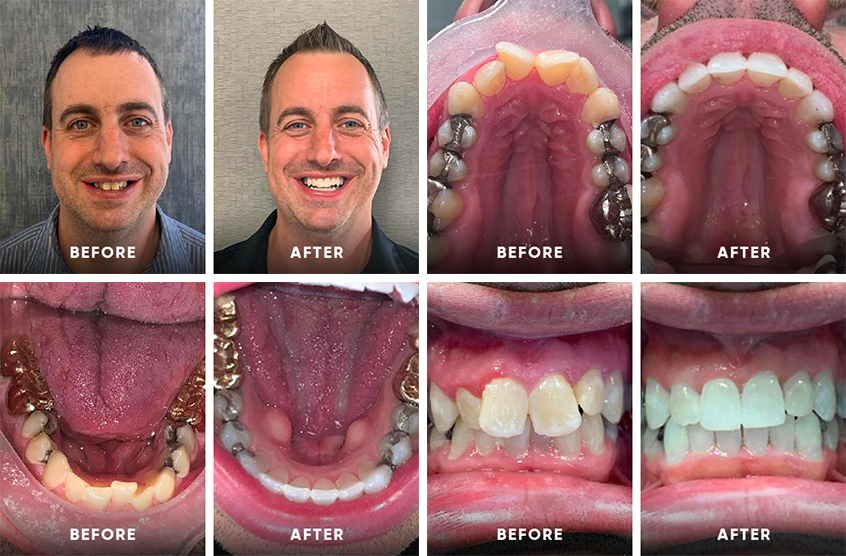What to Expect During Your Invisalign Journey: A Comprehensive Overview
What to Expect During Your Invisalign Journey: A Comprehensive Overview
Blog Article
Invisalign vs. Traditional Braces: Which Choice Is Right for You?
When thinking about orthodontic therapy, the selection in between Invisalign and standard braces provides a number of vital factors that warrant cautious evaluation. Invisalign supplies a very discreet option with detachable aligners, while conventional dental braces supply a much more noticeable yet efficient option for extreme misalignment. Each alternative incorporates unique benefits and disadvantages connected to aesthetic appeals, convenience, treatment period, and price. Recognizing these nuances is important for making a notified decision that aligns with your personal preferences and way of living. The concern stays: which option will ideal meet your orthodontic demands and assumptions?
Introduction of Therapy Alternatives

In comparison, conventional braces are composed of metal brackets and cables that are bonded to the teeth. This approach uses continual stress gradually to attain placement. While reliable for complicated orthodontic issues, traditional braces call for regular sees for adjustments and can pose obstacles in keeping dental hygiene as a result of the problem of cleaning around braces and wires.
Both alternatives have their values, and the option often hinges on specific dental problems, lifestyle choices, and client conformity. Ultimately, consulting an orthodontic expert is crucial for figuring out one of the most suitable therapy strategy tailored to specific requirements. Recognizing the subtleties of each alternative can dramatically affect the general success of orthodontic treatment.
Aesthetic Factors To Consider
A considerable aspect influencing the selection in between Invisalign and typical braces is the aesthetic allure each treatment uses. Invisalign aligners are crafted from clear plastic, making them basically unnoticeable when used.
On the other hand, typical braces consist of metal brackets and cords, which can be much more recognizable. While innovations in orthodontic innovation have actually brought about the growth of smaller sized braces and tinted elastics, typical braces still preserve an even more obvious account. For some people, the visibility of dental braces might deter them from looking for needed therapy.
Inevitably, the option in between Invisalign and standard dental braces might hinge on individual preferences relating to appearances. Individuals that focus on discretion frequently favor Invisalign, while those who are less worried concerning presence might choose traditional braces. Recognizing the aesthetic ramifications of each option is important for making an educated choice that straightens with one's way of living and choices.
Comfort and Convenience

In terms of comfort, Invisalign aligners are detachable, allowing clients to appreciate their favored foods without constraint and maintain optimal oral hygiene. Brushing and flossing are streamlined, as the aligners can be taken out throughout these regimens, whereas traditional braces need cautious steering around braces and cords.
In contrast, traditional braces demand routine changes, making them less hassle-free for those with hectic routines. Generally, the comfort and comfort of Invisalign make it an attractive selection for many individuals looking for orthodontic treatment.
Treatment Period and Effectiveness
While both Invisalign and standard braces are efficient in correcting dental misalignments, the duration of therapy can vary substantially in between both options. Usually, Invisalign treatment can take anywhere from 12 to 18 months, depending upon the complexity of the situation. The clear aligners function by progressively moving teeth into their wanted positions, and routine follow-ups with an orthodontist assistance make sure progress continues to be on the right track.
In contrast, conventional dental braces often require a longer dedication, typically ranging from 18 months to three years. This is due to their fixed nature and making use of brackets and cords, which can be a lot more efficient for complex situations and severe misalignments (Invisalign). The therapy efficiency of conventional braces is well-documented, as they permit exact adjustments and better control over tooth activity
Inevitably, the option between Invisalign and conventional braces might pivot on both the anticipated therapy period and the details oral issues handy. Consulting with an orthodontist is vital, as they can supply customized suggestions based on individual needs, making certain the chosen approach straightens with preferred timeframes and outcomes.
Expense Comparison and Insurance Policy Choices
Price plays a substantial duty in the decision-making process for people taking into consideration orthodontic treatment, whether selecting Invisalign or traditional dental braces. Usually, the expense of Invisalign arrays from $3,000 to $8,000, while traditional dental useful content braces typically set you back in between $2,000 and $6,000. Variables influencing these expenses include the complexity of the instance, the period of treatment, and geographical area.
Insurance policy coverage can dramatically affect out-of-pocket expenditures. Many oral insurance coverage strategies give partial protection for orthodontic therapies, but the specifics can vary extensively. It is critical for individuals to assess their insurance plan to figure out the extent of coverage for either alternative. Normally, typical braces may be click over here more often covered by insurance plans contrasted to Invisalign, which some insurance firms classify as a cosmetic procedure.
Furthermore, numerous orthodontic methods offer adaptable settlement strategies, making both treatment options a lot more easily accessible. Individuals ought to ask about possible financing alternatives and price cuts for ahead of time settlements. Reviewing the complete cost, consisting of insurance benefits and settlement strategies, is important for making an informed decision that straightens with both aesthetic preferences and spending plan considerations.

Final Thought
In summary, the selection in between Invisalign and conventional braces depends upon several factors, including aesthetic choices, comfort, treatment period, and price. Invisalign provides a discreet, detachable choice that facilitates dental health and dietary adaptability, while typical braces may be extra suitable for complicated oral concerns and frequently come at a reduced cost point. Inevitably, appointment with an orthodontist is vital to evaluate individual situations and determine the most ideal therapy choice for accomplishing optimum dental positioning.
When considering orthodontic therapy, the option in between Invisalign and typical dental braces offers a number of important elements that warrant careful examination.Comparing Invisalign and standard dental braces reveals distinct therapy choices for orthodontic improvement.While both Invisalign and standard dental braces are effective in remedying oral imbalances, the period of therapy can vary considerably like this in between the two choices.Cost plays a considerable function in the decision-making procedure for people taking into consideration orthodontic therapy, whether opting for Invisalign or conventional dental braces.In recap, the choice between Invisalign and traditional braces hinges on numerous factors, including aesthetic choices, convenience, therapy duration, and cost.
Report this page